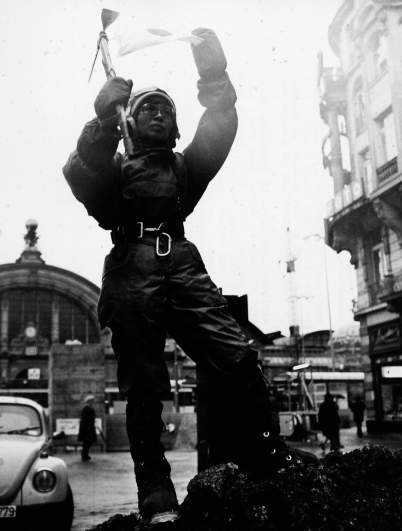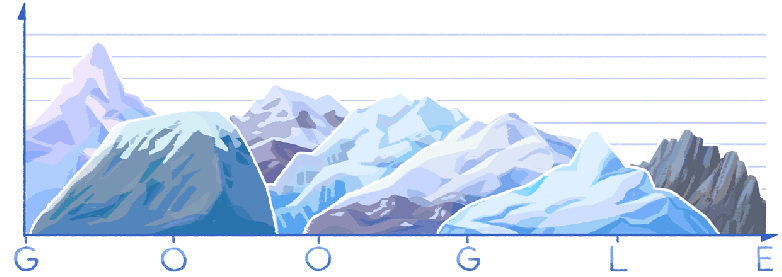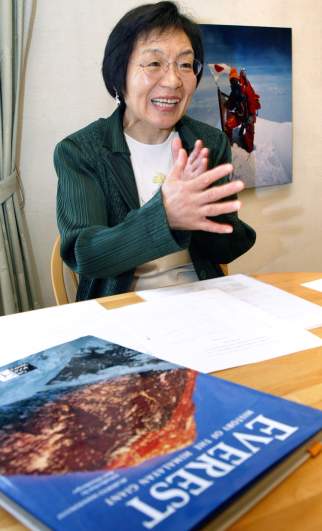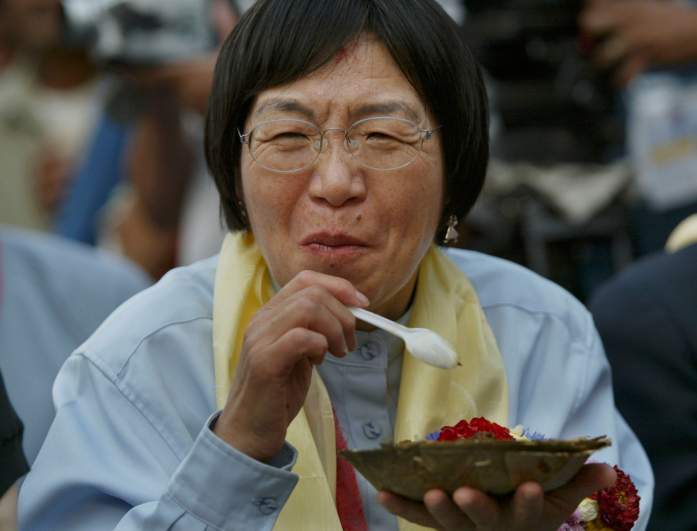
Getty Junko Tabei has loved climbing mountains since childhood.
Junko Tabei was a Japanese mountaineer who became the first woman to reach the summit of Mt. Everest, the world’s highest mountain. Throughout her life, she challenged cultural norms relating to gender in Japan, and she climbed to the top of mountains in 76 different countries.
“Do not give up,” Tabei said, according to Google. “Keep on your quest.” Tabei is honored by a Google Doodle on September 22, 2019, on what would have been her 80 birthday (she died in 2016).
The story of Tabei’s journey to reach the top of Everest matches her life’s journey: Both were remarkable tales of perseverance in the face of great challenges. In fact, she crawled part of the way up Everest after almost being killed in an avalanche. And that was just for starters.
According to NPR, she later became the first woman to conquer the “Seven Summits,” which means she reached the summit of the tallest mountain peak on every single continent on earth. Among those: Africa’s Mount Kilimanjaro and Alaska’s Mount Denali (then Mount McKinley). She did this while facing gender discrimination in a country where women were often expected to stay at home in that era.
“The final ascent was a step-by-step struggle, but when I arrived I didn’t have an overwhelming sense of achievement. It was more like relief. I couldn’t believe the climb was finally over and I had to go down instead of up,” she recalled of scaling Everest, according to Japan Times. “The precious thing about that moment was, beyond being the first woman there, the summit of Everest was utterly beautiful, without a single manmade object in sight.”
Here’s what you need to know:
1. Tabei, Who Was Raised in a Small Japanese Town, Began Climbing Mountains on a Class Trip But Was Frail as a Youth

Portrait of Japanese mountaineer Junko Tabei giving a climbing demonstration next to a rubble pile, outside Frankfurt Station, circa 1975.
Tabei was only 10 years old and living in the small Japanese town of Miharu, when she went on a class climbing trip to Mount Nasu, a local volcano. According to Google, the joy of climbing never left her. The town was located in the Fukushima Prefecture. Tabei was the fifth of seven children. Her father was a printer, The Guardian reported.
She was “frail” as a youth but fought against being labeled the “weak child,” Guardian reported.
She told Outside in an interview that she went to a Tokyo university to study English Literature at first. “In Fukushima at that time, there were not many girls in high school, and hardly any went to university. I was an exceptional case,” Tabei told the publication.

The Junko Tabei Google Doodle.
“I felt a kind of inferiority complex about my speaking with a Fukushima accent, because most of the female students were from cities. I was lucky to find a friend on campus who would go to the mountains with me, so we hiked together many times. When I met a group of male students and learned they were in an alpine club, I felt so envious.”
Soon, she was climbing every weekend. She did manage to earn her degree as well; according to Britannica, she “earned a degree in English and American literature from Showa Women’s University” in 1962.
A book on her life says that “some 75 percent of Japan is mountainous” so the country has produced some world-class mountaineers, also including Yuichiro Miura and Ken Noguchi. But Tabei was different; when she scaled Everest, she was a “housewife and the mother of a 3-year-old,” Japan Times reports.
2. Tabei, a Mother of Two Who Married a Mountaineer, Founded a Ladies Climbing Club But Didn’t Like Focusing on Gender

Japanese climber Junko Tabei, the first woman to summit Mt. Everest in 1975, is greeted by friends during a procession celebrating the 50th anniversary of the ascent of the world’s highest mountain on May 27, 2003 in Kathmandu, Nepal.
Although she was a pioneer for women climbers, Tabei didn’t focus on her gender accomplishment. According to Google, she “once said she preferred to be remembered as the 36th person to climb the world’s highest mountain peak.”
“I did not intend to be the first woman on Everest,” she said, according to Google, which added that she stood only 4 foot 9 inches tall.
Still, she challenged gender norms in Japan, founding the first Ladies Climbing Club, Google noted. According to Japan Times, its slogan was “Let’s go on an overseas expedition by ourselves.” And, of course, she did. But she was crystal clear in interviews about the ways in which she was helping defy gender stereotypes.
“Most Japanese men of my generation would expect the woman to stay at home and clean house,” she said, according to Japan Times. According to NPR, she started the Ladies Climbing Club because she felt mistreated by male climbers. In fact, when she sought sponsors for the Everest trip, she met some resistance, according to NPR, which quoted her as saying, “We were told we should be raising children instead.”
The Everest expedition received scorn in Japanese media at first. “Newspaper articles liked mocking us. They would use the picture of us applying a lip balm and say ‘even in the mountain, they don’t skip wearing the make-up.’ For a lot of people, it was a joke. They didn’t think we would make it,” Tabei said, according to JWEE1975, a website devoted to the expedition. To save money so they could afford the expedition, the women took many cost-saving measures, even making their own sleeping bags.
However, Tabei had a supportive husband. She married a well-known Japanese mountaineer named Masanobu Tabei. They met while climbing and he “both understood her passion and supported her,” The Guardian reported, working at Honda and helping raise their children, Noriko and Shinya.
3. Tabei Survived an Avalanche to Reach the Summit of Mt. Everest But Was Saved by a Group of Sherpas

Japanese mountain climber Junko Tabei, 3rd June 1975. Tabei was the first female to climb Mount Everest, being the first of an all-woman team to reach the summit on 16th May 1975.
An old article in Sports Illustrated on Tabei dramatically describes what it took to reach the Everest summit at age 35. For starters, she almost died in an avalanche, but she was pulled out of it by a group of sherpas.
It was 1975, and she was with a group of other Japanese female climbers when they heard the roar of the avalanche. They were between Mount Nuptse and Mount Lhotse when the snow tumbled down and trapped her and the others. According to SI.com, she “blacked out,” but “had a vision of her 2½-year-old daughter, Noriko, playing outside their home near Tokyo.”
“As soon as I knew everyone was alive,” Tabei told SI.com, of her thoughts after the sherpas pulled her out of the snow, “I was determined to continue.” However, she was injured and it took two days before she could walk again. Still, she forged on.
She described the moment in the Outside interview, saying, “A little after midnight on May 4, five of us were sleeping in a tent at Camp 2. Without any sign, we were hit by an avalanche, and buried under snow. I was tangled up in the tent and pushed under the other four members. I began to suffocate, and thought about how our accident would be reported. Then suddenly, I was pulled up by Sherpas and revived.”
According to SI.com, she even crawled at some points but remained at the head of the team. It took 12 days but on May 16, she made it to the summit, describing it as “smaller than a tatami mat.”
There had been other dangers along the way; according to Conde Naste Traveller, “they were forced to cross a narrow, icy ridge, close to 49ft long; one wrong step would have sent them plunging nearly 21,000ft down.”
JWEE1975, a website devoted to the expedition (Japanese Women’s Everest Expedition), says that the team included “mostly working women.” Among them, “a computer programmer and a juvenile counselor.” The website describes the women’s grit after the avalanche, saying, “Their tents were swept away and buried by snow. Luckily, the tents of their Sherpa guides were safe. Thanks to their prompt rescue efforts, members’ lives were saved. Their tents, however, were badly damaged, and several expedition members including Tabei were injured. Usually, such an event would mean the end of the expedition, but the women refused to give up. They sewed up the tents by themselves and kept on going…”
4. Tabei Continued Scaling Mountains After Everest, Saying She Wanted to ‘Climb Even More’

Junko Tabei.
The Everest accomplishment was a huge one, but Tabei didn’t stop there. She kept climbing. “I want to climb even more mountains,” she said in a 1991 interview, according to the Japan Times. “To think, ‘It was great,’ and then die.”
Asked why she kept climbing after Everest, Tabei told Outside, “It is because I love mountains. I love to go wherever I’ve never been before. So I am challenging myself to climb all the highest peaks of all countries of the world. I am now 76, and have scaled the highest peaks of 76 countries. I am suffering cancer but I would like to keep going my way and climb mountains.”
That was a year before she died of cancer. She continued climbing even after the diagnosis.
5. Tabei Devoted Her Later Years to Environmentalism

GettyJunko Tabei
In the era when Tabei was climbing, it was hard to get a permit to scale Everest and it was truly a feat that required grit and determination. Now, according to Conde Naste Traveller, permits are easier to get, professional expeditions guide climbers, and climbing Everest has turned into a “leisure” activity that is damaging the peak. Tabei understood this.
She spent her later years focusing on “environmental initiatives, especially sustainable mountaineering, ” according to the publication, which described her as leading the Himalayan Adventure Trust of Japan, “an organisation that was set up to preserve the Everest habitat.”
According to Britannica, “She later became an environmental advocate and completed graduate studies at Kyushu University, studying the impact of the garbage left on mountains by climbers.”
READ NEXT: The Life of Famed Sculptor Ruth Asawa.